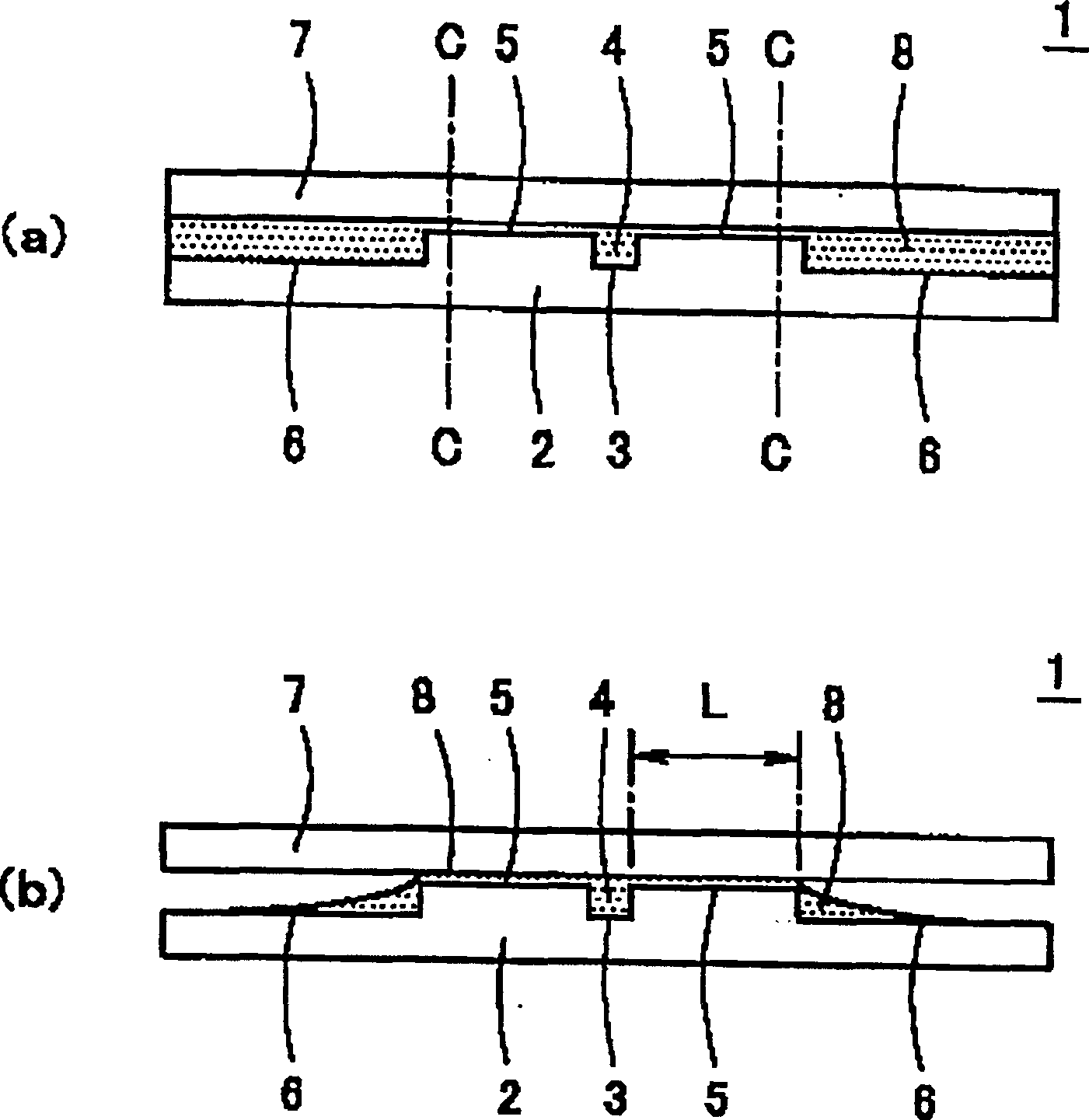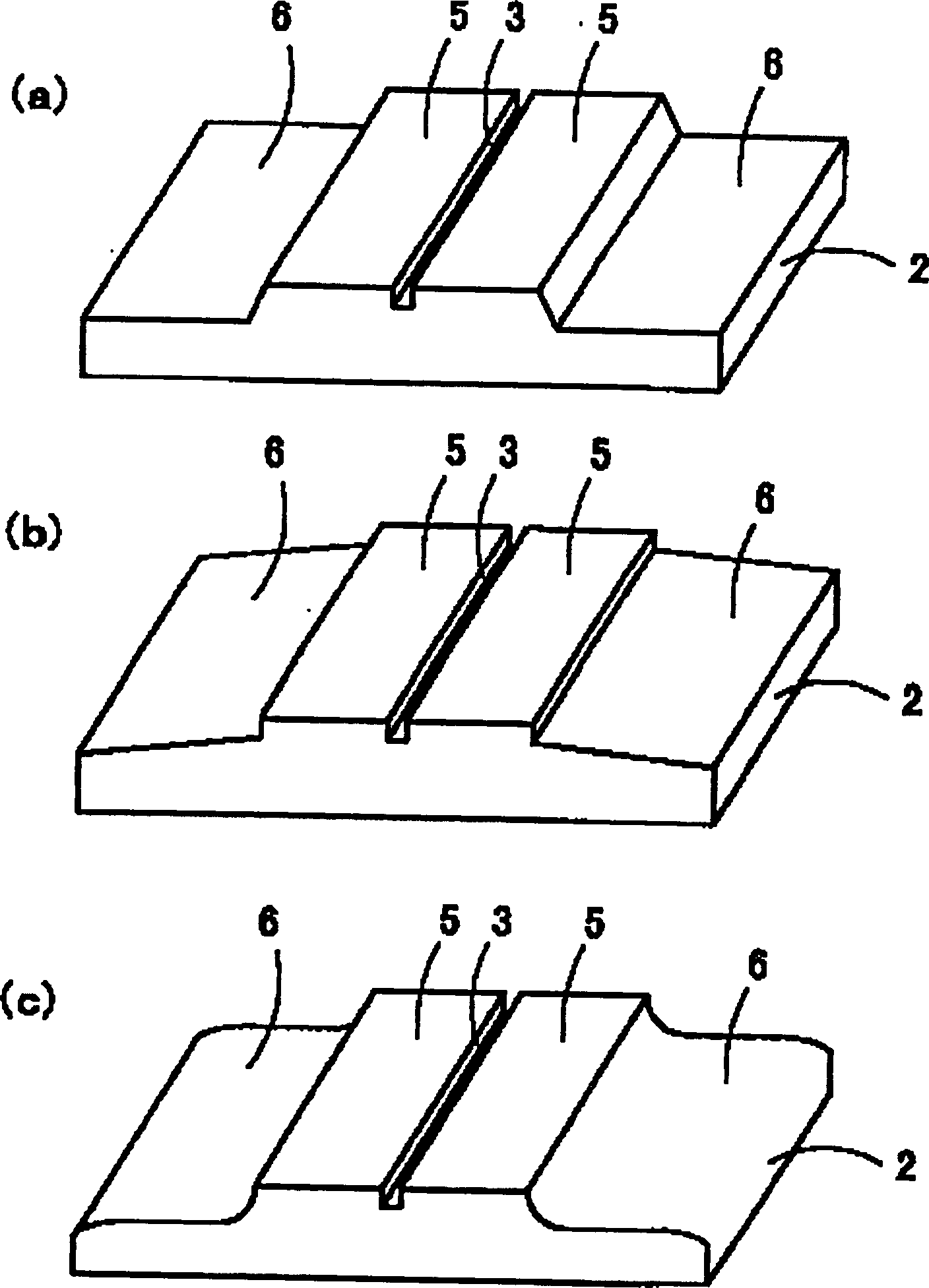Light guide and mfg. method thereof
A manufacturing method and optical waveguide technology, applied in the direction of optical waveguide light guide, coupling of optical waveguide, light guide, etc., can solve the problems of low productivity, lower S/N ratio, lower pass rate, etc., achieve high batch productivity, improve S /N ratio, the effect of speeding up the spreading speed
- Summary
- Abstract
- Description
- Claims
- Application Information
AI Technical Summary
Problems solved by technology
Method used
Image
Examples
no. 2 approach
[0119] Figure 11 (a)(b)(c)(d) are cross-sectional views illustrating a method of manufacturing the optical waveguide 15 according to another embodiment of the present invention. This is implemented, for example, by image 3 The process will have the cladding plate 2 of groove 3, flat part 5, pit 6 to make ( Figure 11 (a)) Afterwards, UV-curable transparent resin 8 is dripped onto the clad plate 2 ( Figure 11 (b)). Next, press the transparent resin 8 on the cladding plate 2 with the die 13, so that the transparent resin 8 is filled in the groove 3, at the same time, the transparent resin 8 on the flat part 5 is extended and thinned, and the excess transparent resin 8 rows to pit 6 side ( Figure 11 (c)). Apply a predetermined pressure to make the film thickness of the transparent resin 8 between the flat part 5 and the stamper 13 a desired film thickness, and after a predetermined time passes, press the transparent resin 8 from the back side of the cladding plate 2 It ...
no. 4 approach
[0122] Figure 13 (a) (b) (c) (d) (e) (f) are cross-sectional views illustrating a method of manufacturing the optical waveguide 17 according to yet another embodiment of the present invention. In this embodiment, the transparent resin 11 ( Figure 13 (a)), by irradiating ultraviolet rays to the transparent resin 11, the clad plate 2 is formed on the upper surface of the glass plate 12 ( Figure 13 (b)). Grooves 3 , flats 5 and dimples 6 are formed on the upper surface of the cladding plate 2 . Then, ultraviolet curing type transparent resin 8 is dropped on this cladding board 2 ( Figure 13 (c)). Next, press the transparent resin 8 on the cladding plate 2 with the die 13, so that the transparent resin 8 is filled in the groove 3, at the same time, the transparent resin 8 on the flat part 5 is extended and thinned, and the excess transparent resin 8 rows to pit 6 side ( Figure 13 (d)). Then, a predetermined pressure is applied to make the film thickness of the transpar...
no. 5 approach
[0124] Figure 14 (a) (b) (c) (d) are cross-sectional views illustrating a method of manufacturing the optical waveguide 18 according to still another embodiment of the present invention. This implementation is, as Figure 14 As shown in (a), in the first cladding plate 2 after manufacture, a triangle is formed between the groove 3 and the dimple 6, and the upper end thereof becomes a pointed portion 19, and the flat portion 5 is not formed. After dripping the ultraviolet curable transparent resin 8 on the cladding board 2 ( Figure 14 (b)), press the transparent resin 8 on the cladding plate 2 with the press die 13, so that the transparent resin 8 is filled in the groove 3. At the same time, the tip portions 19 on both sides of the groove 3 are flattened by the pressing force of the die 13 to form flat portions 5 on both sides of the groove 3 . And, the transparent resin 8 on the flat portion 5 is extended and thinned, and the excess transparent resin 8 is discharged to th...
PUM
 Login to View More
Login to View More Abstract
Description
Claims
Application Information
 Login to View More
Login to View More - R&D
- Intellectual Property
- Life Sciences
- Materials
- Tech Scout
- Unparalleled Data Quality
- Higher Quality Content
- 60% Fewer Hallucinations
Browse by: Latest US Patents, China's latest patents, Technical Efficacy Thesaurus, Application Domain, Technology Topic, Popular Technical Reports.
© 2025 PatSnap. All rights reserved.Legal|Privacy policy|Modern Slavery Act Transparency Statement|Sitemap|About US| Contact US: help@patsnap.com



